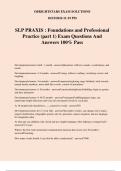©BRIGHTSTARS EXAM SOLUTIONS
10/23/2024 11:19 PM
SLP PRAXIS : Foundations and Professional
Practice (part 1) Exam Questions And
Answers 100% Pass
Developmental norms: birth - 1 month - answer✔phonation: reflexive sounds, vocalizations, and
nasals
Developmental norms: 2-4 months - answer✔Cooing: reflexive smiling, vocalizing vowels, and
laughing
Developmental norms: 4-6 months - answer✔expansion/exploring stage: bilabials, look towards
named family members, more adult like vowels, control of articulators
Developmental norms: 6-10 months - answer✔canonical/reduplicated babbling: begin to gesture
and have intonation
Developmental norms: 8-10/12 months - answer✔variegated babbling/jargon stage: can
understand simple directions and voice all consonants/vowels in vocal play
At 18 months kids should have ____expressive words - answer✔50
Developmental norms for 2-3 year olds - answer✔descriptive stories, can change convo topics,
request clarification, telegraphic speech, ask wh- questions, express negation, and use language
for imaginative play
At what age can children code switch and use simpler language when talking to younger kids? -
answer✔3-5 years
What is the first early intentional communication function that occurs at 8-10 months? -
answer✔Protesting
How many words should 3 year olds be able to understand? - answer✔1000
, ©BRIGHTSTARS EXAM SOLUTIONS
10/23/2024 11:19 PM
Correct order of speech sound acquisition. Vowels first then....? - answer✔Vowels, nasals, stops,
fricatives, liquids, afficates/clusters
At 15-18 months what consonants should children be able to produce? - answer✔b, d, t, m, n, h,
w
In which order do children learn to say j, p, th, k? - answer✔p --> k --> th --> j
phonetic adaptation - answer✔the alteration in physiologic vocal structure movement in the
pronunciation of a phoneme due to proceeding phoneme
Assimilation - answer✔The alteration of a speech sound because of an adjacent sound
Why might a vocab spurt not be happening? - answer✔lack of phonological sophistication
Phonetic placement - answer✔phoneme in isolation
Coalescence - answer✔2 adjacent sounds replaced by a 3rd different sound (swim --> fim)
What processes should be gone at 3? - answer✔weak syllable deletion, final consonant deletion,
fronting, reduplication, and consonant assimiliation
What processes persist after 3? - answer✔cluster reduction, stopping, and gliding
When should a lisp be gone? - answer✔around 6 years old
Sonorants - answer✔sounds that can be produced continuously at the same pitch, made without
turbulent airflow=nasals, glides, and liquids
Stridents - answer✔sounds made with turbulent airflow and high mouth friction, forcing air
through a small opening (affricates and fricatives)
Sibilants - answer✔sounds with longer duration/stridency = affricates and fricatives
Obstruents - answer✔notable air obstructions= affricates, fricatives and stops
Continuants - answer✔continuous stream of air through the vocal tract (VT; (fricatives, glides,
liquids and laterals NOT nasals, stops and affricates)
Consonantals - answer✔sounds made by contracting the VT, all consonants besides /l/ and /r
Anterior sounds - answer✔sounds made with the tongue before where it is produced for /sh/
Coronal sounds - answer✔when the tongue blade is above the schwa position
, ©BRIGHTSTARS EXAM SOLUTIONS
10/23/2024 11:19 PM
Approximates - answer✔glides and liquids
What influences a listener's perception of voicing? - answer✔vowel duration --> vowels that
precede unreleased voiced stop consonants are as much as 1.5 times as long as vowels that
precede voiceless stops
IPA for vowels - answer✔
Content - answer✔semantics
Form - answer✔phonology, morphology, and syntax
Use - answer✔pragmatics
What does 'embedded' mean? - answer✔rearranging something in a sentence
What is the correct order of early learned morphemes? - answer✔present progressive (ing),
plural, simple irregular past (drank), possessives, regular past tense (-ed), and 3rd person singular
progressive (he runs)
Parts of a syllable - answer✔onset, nucleus (vowel), coda
When does subject, verb, object develop? - answer✔2 years old
Minimal distance principle - answer✔the distance between the subject and verb
Speech act - answer✔communicative intent
Type token ratio? What is a typical ratio for 3-8 year olds? - answer✔measures children's lexical
diversity of expressive words during conversations (# of different words/total words), .5 or 1:2 is
typical for 3-8-year olds
What type of verbs are learned first? - answer✔transitive (action)
Deictic terms (here, there) are develop later because? - answer✔they have to take the perspective
of the communicative partner
Copula - answer✔a connecting word, in particular a form of the verb 'be' connecting a subject
and complement (ex. were)
Anaphora - answer✔the use of a word referring to or replacing a word used earlier in a sentence,
to avoid repetition (ex. replacement of a noun with a pronoun)
semantic bootstrapping - answer✔a linguistic theory that children use semantics to understand
syntax




